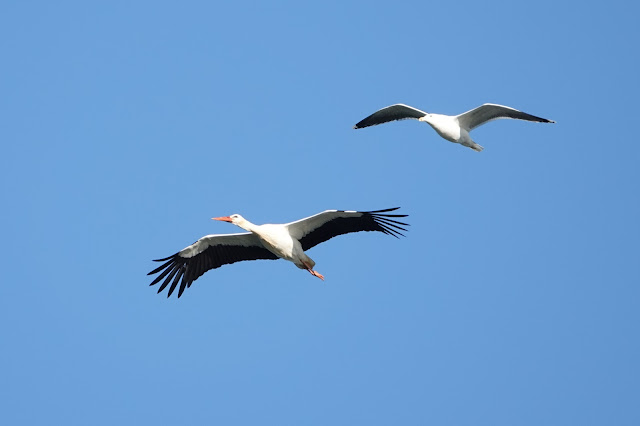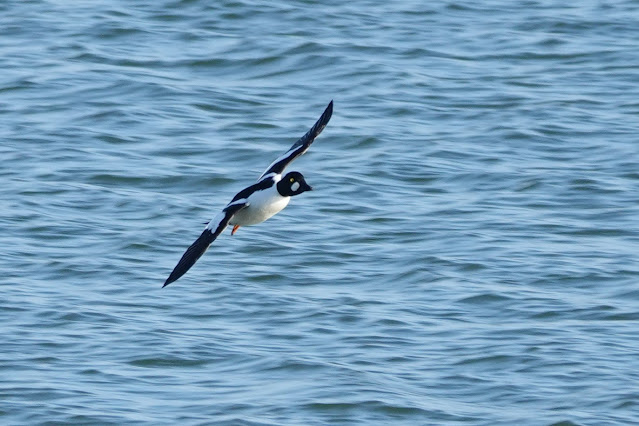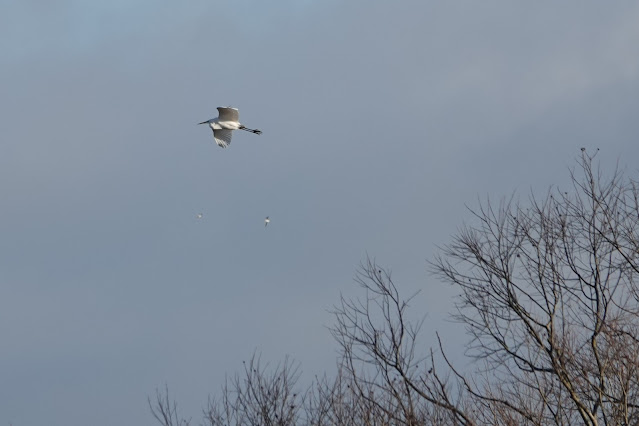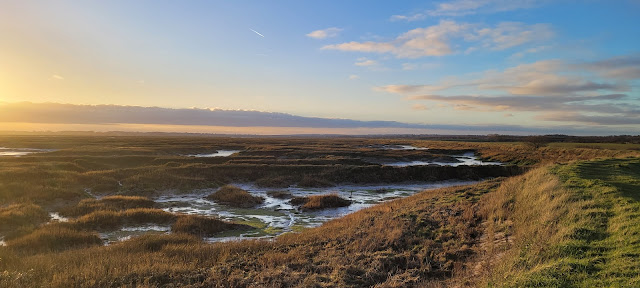A non-frosty but very cold, bright start saw us heading from
darkest North Kent into Essex for the day and with thankfully no real traffic
delays we made good time to our start point at Goldhanger. It was colder here with some frost but it was
very calm and Sol was already grinning inanely at me in the knowledge that it
was going to get in the way while we were looking at the Blackwater.
A few small birds were quickly added while we waited for the
day’s crew to assemble with two Greenfinches, Fieldfares, Redwings and a
singing Coal Tit the pick. I got slightly distracted by a Bramble clump that
not only held the expected Stigmella aurella but also the more unusual
Ectoedemia rubivora with it mines inside a reddened section of the leaf.
 |
| Ectoedemia rubivora |
 |
| Ectoedemia rubivora |
We walked down to the river wall annoyingly the tide was
already far further in that I had calculated but there were still some edges
and spits with Redshank, Turnstone, Dunlin, Black-tailed Godwits, Lapwings and
Curlew feeding on them while grumbling families of Dark-bellied Brent Geese
surface fed around them.
Three hundred shining Golden Plovers were spread out over
the ploughed field with a few Lapwings and a Little Egret seemed a bit lost as
it looked for an open ditch in which to hunt.
Most were frozen solid and the water levels had obviously dropped since
the weather got cold as there were sheets of thick ice left stranded in the
reeds 18 inches above the current level.
Cetti’s Warbler, Reed Bunting and Meadow Pipit were encountered and a
Water Rail quietly ‘kipped’ from the dyke below us.
 |
| Golden Plovers |
 |
| Hanging ice sheets |
The Blackwater itself was very disappointing and I could not
find any Divers or Mergansers with just a couple of small groups of Great
Crested Grebes but eventually we did briefly find a Slavonian Grebe with three
Littles and two Goldeneye but it was hard work.
The breach wader roost site was being utilized but even then
the actual numbers were small but with the light the right way it meant that
the all sparkled and the group got great views of Knot, Dunlin, Grey and Ringed
Plovers while several hundred Brents moved between the bay and the fields
beyond. The sound of a large flock of
Brent Geese is evocative of any Essex winter. The guttural mumblings reach you
from afar and fill you up as a background noise. One minute it is there and then they settle
again and silence resumes.
 |
| Dunlin, Turnstone, Grey Plover & Black-tailed Godwits |
 |
| Brent Geese |
Looking back up toward Maldon there were vast flocks of
swirling Knot, and Avocet, Pintail and Oystercatcher were all new as we started
to retrace our steps. I took us on an
inland route along a fine hedge line (adding Ectoedemia heringella in the only
Holm Oak) and we got some close views of a flock of Fieldfare and several
grovelling Skylarks while a winter wheat field held a mixed wader party of
semi-roosting Golden Plover, Turnstone, Ringed Plovers and Dunlin. A Green Woodpecker called somewhere back
towards the village where Great Spotted was added shortly afterwards.
 |
| Fieldfare |
 |
| Ectoedemia heringella |
Onwards to Abberton and a first stop on the Layer de la Haye
causeway. An immature Red Kite drifted over as we got out of the cars and as we
reached the top of the steps Jim said ‘White Stork!’ and there above us was the
local wandering bird with a Great Black-backed Gull in tow.
 |
| Red Kite |
 |
| White Stork & monster Great Black-backed Gull |
It circled right over our heads and gave us a fantastic
view. Within a few minutes we had found three female and a 1w male Scaup just
below us, the Black-necked Grebe playing hand and seek amongst the Tufties and
a dapper little Rock Pipit that was feeding on the margin.
 |
| Black-necked Grebe & Great Crested Grebe - Richard Hanman |
 |
| 1w m Scaup |
 |
| f - not sure if 1w -Scaup |
 |
| 1w m Scaup |
 |
| Rock Pipit |
Three Bewick’s Swans were along the other bank where I saw
them on Monday and we even picked up the Great Northern Diver snorkelling just
behind the mass of gulls out on the point.
We were on a roll!
I scanned the closer gulls and was pleased to find a 1w
Caspian Gull close enough to actually show the crew and walked down to where
Richard was papping Goosanders by the sluice to show him. He pointed at a gull just below us and said ‘
Isn’t that one?’ He was quite correct and it was good to be able to go through
the salient features on a bird at 20m range. It was quite a small 1w bird and a
little darker than the first one but was typically aggressive and even did the classic
wings arched, head thrown back long call so distinctive of the species.
 |
| 1w Caspian Gull |
 |
| 1w Caspian Gull #1 |
The original bird that I found then conveniently swan over
and paddled around too and if anything was an even more striking individual.
 |
| 1w Caspian Gull #2 |
Two of the Bewick’s Swans also came to join
us in the corner for no apparent reason but the local pair of Mute Swans soon
pushed them back across the reservoir.
Their plaintive bugling was joy to hear.
Goosanders and Goldeneye dived at the sluice mouth and a Great White
Egret headed over the visitors centre while Ruff, Lapwings, Redshank, Dunlin
and Black-tailed Godwits were on the banks with hoards of dabblers – and breath!
 |
| m Goosander |
 |
| Bewick’s Swan |
 |
| Bewick’s Swans |
 |
| Goldeneye |
 |
| Goldeneye |
 |
| Goldeneye |
A coffee and lunch beckoned so we headed for the indoor
warmth where it was good to catch up with an array of local Essex faces I had
not seen in some time as well my old RSPB compadre Alex Smith who now works for
the EWT. I could not find the Great Northern Diver for
Richard who had missed it earlier so we slid our way down the ice covered path
to the Island Hide and promptly picked it up over the back along with the white
faced female Long-tailed Duck and a good number of Goldeneye and
Goosander. Another 1w Caspian and the
first Lesser Black-backed Gull was seen amongst the throng on the water and
both male and female Marsh Harriers regularly caused havoc with the Teal that
were feeding along the edge.
Having cleaned up on all the goodies at that end we drove
around to the Layer Breton Causeway and spent an whole 15 seconds trying to
find the 1w male Smew that decided to swim from under the trees to right alongside
us before swapping sides of the causeway and ending up with two Goosander by
the weir! We could not have been more
lucky! Four Great White Egrets were
dotted around but the Bittern did not chose that moment to reveal itself. The Baikal Teal x Eurasian Teal hybrid was on
the causeway with the mass of Mallards and it was the first time that I had
actually seen this delightfully striking duck since Paul Hawkins found it in urban
Ardleigh Green several years ago!
 |
| Jacqui having a Black-headed Gull moment... |
 |
| Baikal Teal x Eurasian Teal |
 |
| Baikal Teal x Eurasian Teal |
 |
| Great White Egret |
 |
| 1w male Smew - white flecks showing on the nape and solid black eye patch |
The light was holding but the breeze was picking up and so
as we were ahead of my notional schedule we wiggled our way down to Copt Hall
and headed out for a walk along the sea wall on the other side of Salcott creek
with the hope of a few new birds for the day including Barn Owl. It got off to a great start with a 1w Med Gull hawking
invisible insects over the first winter crop field while ragged skeins of Brent
Geese could be seen massing over Tollesbury.
 |
| 1w Med Gull |
Song Thrushes, Meadow Pipits, Reed Buntings and the odd chacking
Fieldfare were seen in the margins but a bird scarer was keeping the geese on
the move. Jacqui picked up a Barn Owl
quartering the back of the field but it would prove to be our only sighting
while Marsh Harriers were all around including an immature male. The tide was now out a fair way in the creek
and I was pleased to complete our Sawbill list with a pair of Red-breasted Mergansers
fishing around the boats with Herring Gulls watching their every move.


Huge snaky lines of Cormorants started to appear in the east
from the direction of Bradwell power station and all made their way inland and
over Peldon church to get to Abberton for the evening while clouds of Brent
Geese continued to be found in any direction we looked. The Golden Hour illuminated the Plovers in the final meadow and a couple of close hunting Harriers
but try as we might we could not coax any further owls or raptors to the tally
for the day that ended up just shy of 100.
 |
| Cormorants |
With a narrow bank of cloud cutting off the falling sun, we began the trudge back and reached the cars as the last light glimmered across the fields at the end of a delightfully successful day
.















































Thanks for a great day birding Howard, looking forward to the next one.
ReplyDelete